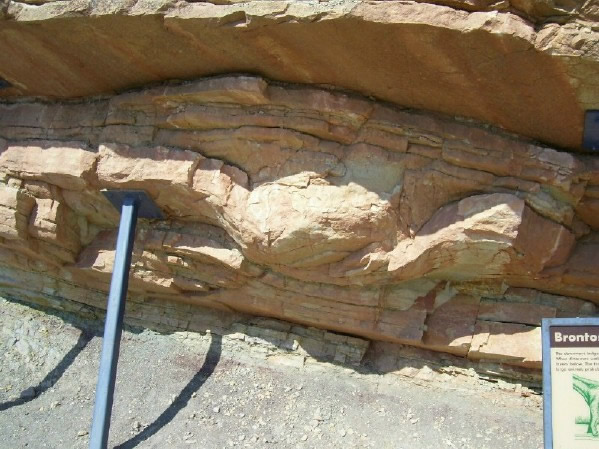The Morrison Formation

"Brontosaurus bulge" - Morrison Formation sandstone depression, possibly the underside impression of a sauropod foot as the plant eater walked on soft mud 150 million years ago - west side of Dinosaur Ridge, Morrison, Colorado.
Long Neck Meadow
The lush vegetation of the Morrison lagoon environment supported a variety of animal life, including the giant plant-eating sauropods, such as Brontosaurus.[1] Between 1877 and 1879 quarries near Morrison, Colorado would yield the bones of a crocodile, the dinosaur Stegosaurus, and two brontosaurs, Diplodocus and Apatosaurus. These discoveries would give the formation its name - Dinosaur Ridge, otherwise known as Long Neck Meadow, for the long-necked sauropods. The dinosaur discoveries did not lead to discoveries about their diet. Few fossil plants are found on Dinosaur Ridge in the same strata as the dinosaur bones.[2]
Footnotes
(1) Andrew M. Taylor, Ph.D., "Guide to the Geology of Colorado," Cataract Lode Mining Company, (Golden, CO 1999), pp. 66-67;
Ralph Lee Hopkins and Lindy Birkel Hopkins, "Hiking Colorado's Geology," The Mountaineers, (Seattle, WA 2000), p. 86.
(2)Peter J. Modreski, "Geochemical and Mineralogical Studies of Dinosaur Bone from the Morrison Formation at Dinosaur Ridge,"
in "The Mountain Geologist," Volume 38, Number 3, Rocky Mountain Association of Geologists, (Denver, CO July 2001), p. 115;
Kirk R. Johnson and Robert G. Raynolds, "Ancient Denvers: Scenes from the Past 300 Million Years of the
Colorado Front Range," Denver Museum of Nature & Science, (Denver 2003), p. 12.
